 advertisements advertisements
|

|
Frank Borman, astronaut who led first flight to the moon, dies at 95
November 9, 2023 — Former NASA astronaut Frank Borman, who in 1968 led the first mission to fly humans to the moon, has died at the age of 95.
Borman's death in Billings, Montana on Tuesday (Nov. 7) was confirmed by NASA.
"Today we remember one of NASA's best. Astronaut Frank Borman was a true American hero," said NASA Administrator Bill Nelson in a statement. "Frank knew the power exploration held in uniting humanity when he said, 'Exploration is really the essence of the human spirit.'"
"His service to NASA and our nation will undoubtedly fuel the Artemis Generation to reach new cosmic shores," said Nelson.
A member of NASA's second class of astronauts, Borman lifted off twice into space. On his second mission, Apollo 8, he commanded the first crew to orbit the moon.
Launched on Dec. 21, 1968, Borman, Jim Lovell and Bill Anders became the first astronauts to ride atop the Saturn V, which at the time was the United States' most powerful rocket. The booster's third stage accelerated the Apollo 8 crew from 17,000 to 24,000 miles per hour (27,000 to 39,000 kph), the fastest any astronauts had traveled up to that point in history.
"The Saturn V was a unique vehicle," said Borman in a 1999 NASA oral history interview. "It was powerful and noisy and vibrated, and the stagings were really kind of violent. But when you got on the third stage, the S-IVB, it was smooth and quiet."
Borman and his two crewmates arrived at the moon three days after leaving Earth. Apollo 8 entered an elliptical orbit that brought the crew as close as 115 miles (185 kilometers) of the lunar surface. On the first of their 10 revolutions, Borman, Lovell and Anders became the first people to see firsthand the far side of the moon and then, while coming out from behind the moon for the fourth time, the first to see in-person "Earthrise."
Following the excitement of seeing their home planet and its nearest neighbor in new ways, Borman slept for two orbits and then relieved his crewmates to do the same. On their ninth trip around the moon, the now rested crew hosted a live television broadcast back to Earth, providing their first chance to share what they thought of the lunar surface below.
"A vast, lonely, forbidding expanse of nothing," said Borman, describing what he saw while looking out of the command module's windows.
The Dec. 24 broadcast concluded with Borman and his crew in reading from the bible's Book of Genesis.
"And from the crew of Apollo 8, we close with good night, good luck, a Merry Christmas and God bless all of you — all of you on the good Earth," Borman said, ending what immediately became an iconic moment of the Apollo program.
"Looking back at the Earth on Christmas Eve had a great effect, I think, on all three of us. I can only speak for myself, but it had for me," Borman later said in his NASA oral history. "Because of the wonderment of it and the fact that the Earth looked so lonely in the universe. It's the only thing with color. All of our emotions were focused back there with our families as well. So that was the most emotional part of the flight for me."
During their time in lunar orbit, the Apollo 8 crew collected imagery that would later help pick the future sites where astronauts would land on the moon. Borman, Lovell and Anders left the moon on Christmas Day and splashed down on Dec. 27 in the Pacific Ocean where the USS Yorktown aircraft carrier was waiting to assist in their recovery.
The Apollo 8 mission set many firsts, including the first to include crew members who had already flown together.
Borman's first spaceflight, which launched three years before Apollo 8, paired him with Lovell, who was also making his first trip into space. The Gemini 7 mission was designed to test and discover the difficulties with keeping a crew in space for as long as the Apollo landing missions were expected to extend.
For two weeks, Borman and Lovell lived together in the cramped confines of their two-seat capsule. The pair evaluated freeze-dried food options, collected medical data on each other and were the first NASA astronauts to doff their pressure suits in-flight, as later Apollo crews would on the way to and from the moon.
Eleven days into their mission, Borman and Lovell's spacecraft also became the passive target for the first rendezvous between two crewed vehicles.
Gemini 6A, which launched with Wally Schirra and Thomas Stafford after Gemini 7 was already in orbit, came within 1 foot (30 cm) of Borman's and Lovell's spacecraft, demonstrating the close proximity maneuvers that would be needed to fly the Apollo spacecraft to and from the moon. After 5 hours and 19 minutes, the two spacecraft parted ways.
"It was a real high point to see this bright light, it looked like a star, [come] up, and then eventually we could see it was a Gemini vehicle. And we found that ... the autopilot for the controls were perfect. You could fly formation with no problem," said Borman.
Gemini 7 landed on Dec. 18, 1965, in the North Atlantic Ocean, and was brought aboard the USS Wasp for the trip back to shore.
In total, over the course of the Gemini 7 and Apollo 8 missions, Borman logged 19 days, 21 hours and 35 minutes in space,
Frank Frederick Borman II was born on March 14, 1928, in Gary, Indiana, though he grew up and considered Tuscon, Arizona to be his hometown.
Borman graduated with his Bachelor of Science from the U.S. Military Academy in West Point, New York in 1950, ranking eighth in his class. He was commissioned as a second lieutenant in the U.S. Air Force and reported to Perrin Air Force Base in Texas for basic flight training. He then trained to become a fighter pilot, earning his pilot wings at Nellis Air Force Base in Nevada in 1951.
A perforated eardrum, the result of his practicing dive bombing with a bad head cold, temporarily grounded Borman until Sept. 22, 1952, but in the interim he was assigned to the 44th Fighter-Bomber Squadron, where he performed non-flying duties. Borman then became a jet instrument flight instructor at Moody Air Force Base in Georgia, before earning his master's in aeronautical engineering from the California Institute of Technology (Caltech) in 1957. He then was ordered back to West Point to serve as an assistant professor until 1960.
Borman next reported to the U.S. Air Force's Experimental Flight Test Pilot School at Edwards Air Force Base in California, where he graduated as a test pilot alongside future fellow Apollo astronauts Michael Collins and Jim Irwin. Thomas Stafford, who Borman would later meet up with in space during Gemini 7, was one of his instructors.
In 1961, Borman became one of the first five students to attend the Aerospace Research Pilot School, a postgraduate school for test pilots to prepare to become astronauts. He was among the 11 candidates the Air Force submitted for NASA's second astronaut class, who upon their selection on Sept. 17, 1962, were dubbed the "Next Nine."
Borman's first role at NASA was to be the astronaut overseeing the human-rating of the Titan II booster that was being built by Martin Marietta (today, Lockheed Martin) for Project Gemini. He also underwent jungle and water survival training, as well as took part in geology lessons and field trips. Of the latter, he later said, "I didn't care about picking up rocks ... I wanted to beat the Soviets to the moon."
Borman's first flight assignment was to backup Mercury astronaut Gus Grissom as the pilot of Gemini 3, the first crewed mission of the new program. Grissom and Borman did not work well together, though, so when circumstances opened a seat on the Gemini 3 prime crew, Borman was reassigned to back up Gemini 4, which in turn led to him rotating onto the flight crew for Gemini 7.
After returning from his first flight, Borman was assigned to backup the second Apollo mission, which was planned to fly a command module in Earth orbit, before commanding a mission to test the lunar module in Earth orbit. Then tragedy struck the program.
The Apollo 1 crew (Grissom, Ed White and Roger Chaffee) died in a fire during a test on the launchpad in January 1967. Borman was chosen by NASA as the only astronaut to sit on the accident review board. In that role, Borman testified before Congress. His passionate defense of the space program was credited as helping convince lawmakers not to cancel the moon landings.
Turning down an assignment as manager of the moon landing program, Borman took a temporary position at North American Aviation's (today, Boeing) plant in Downey, California, to oversee the changes being made to the Apollo command module.
Upon returning to NASA's Manned Spacecraft Center in Houston, Borman faced a decision. The lunar module was not yet ready to fly and intelligence suggested that the Soviets were nearing an attempt at a lunar flyby. Instead of repeating what Apollo 7 had already accomplished, Borman was asked if he and his crew would accept a mission to fly a command module into lunar orbit and back. He accepted and the new plan for Apollo 8 was made public.
In 1968, before he left Earth to orbit the moon, Borman was offered the command of the first moon landing mission. He turned it down, having already decided that Apollo 8 was going to be his last flight.
"My reason for joining NASA was to participate in the Apollo program, the lunar program, and hopefully beat the Russians. I never looked at it for any individual goals," Borman said. "I never wanted to be the first person on the moon and frankly, as far as I was concerned, when Apollo 11 was over, the mission was over. The rest was frosting on the cake."
Instead, Borman watched Neil Armstrong and Buzz Aldrin walk on the moon from the White House, serving as a NASA liaison to President Richard Nixon. Borman also accompanied Nixon to the USS Hornet for the recovery of the Apollo 11 crew.
In June 1970, Borman retired from NASA and the U.S. Air Force with the rank of colonel. He completed Harvard Business School's advanced management program and joined Eastern Air Lines as its senior vice president for operations. In May 1975, Borman was elected president and chief operating officer of the company. He was named chief executive officer in December 1975 and became chairman of the board in December 1976.
Retiring from Eastern 10 years later, Borman served as a member of the boards of directors for Home Depot, National Geographic, Outboard Marine Corporation, Automotive Financial Group, Thermo Instrument Systems and American Superconductor. From July 1988 to August 1996, he was chief executive of Patlex Corporation, a company specializing in lasers.
In 1998, Borman purchased a cattle ranch in southern Montana, running 4,000 head of cattle on 160,000 acres (65,000 ha). He also rebuilt a rare World War II single-engine fighter, the Bell P-63 Kingcobra, which he exhibited and flew in air shows.
For his service to the nation and the space program, Borman was awarded numerous honors and medals. Together with Lovell, Borman twice was bestowed with the Harmon Trophy and as commander of Apollo 8, he was presented the Robert J. Collier Trophy for "achievement in astronautics." On Oct. 1, 1978, Borman became one of the first six astronauts given the Congressional Space Medal of Honor, the highest award reserved only for U.S. space explorers.
In 1970, the International Astronomical Union named a crater on the moon's far side for Borman. In 2004, NASA named Borman an Ambassador of Exploration and awarded him (in name only) a moon rock, which in 2006 he placed on display at the Pima Air and Space Museum in Tucson, Arizona.
Borman was inducted into the National Aviation Hall of Fame and International Space Hall of Fame in 1982, the International Air and Space Hall of Fame in 1990 and the U.S. Astronaut Hall of Fame in 1993.
In 2018, Borman donated his personal space memorabilia to the Experimental Aircraft Association (EAA), which created "The Borman Collection: An EAA Member's Space Odyssey," a permanent exhibition at EAA Aviation Museum in Oshkosh, Wisconsin.
Borman, together with his Apollo 8 crewmates, were named TIME Magazine's Men of the Year in 1968. In 1998, he was portrayed by actor David Andrews in the HBO miniseries "From the Earth to the Moon." Borman appeared as himself in multiple documentaries, including the 2018 "First to the Moon" directed by Paul Hildebrandt.
Borman collaborated with Robert Sterling to publish his autobiography, "Countdown," in 1988. Borman was also interviewed for "A Man on the Moon: The Voyages of the Apollo Astronauts" by Andrew Chaikin, "Genesis: The Story of Apollo 8 - The First Manned Mission to Another World" by Robert Zimmerman, "Apollo 8: The Thrilling Story of the First Mission to the Moon" by Jeffrey Kluger and "Rocket Men: The Daring Odyssey of Apollo 8 and the Astronauts Who Made Man's First Journey to the Moon" by Robert Kurson.
Borman and his wife Susan were the subject of "Far Side of the Moon: Apollo 8 Commander Frank Borman and the Woman Who Gave Him Wings" by Liisa Jorgensen.
Before his death, Borman was the oldest living American astronaut, a distinction that now falls to Borman's crewmate, Lovell, who is 11 days younger. Apollo 8 was also the last of NASA's Apollo crews to all be living.
Borman is preceded in death by his wife of more than 70 years, Susan Bugbee, who died in 2021. The Bormans had two sons, Frederick Pearce and Edwin Sloan, born in 1950 and 1952, respectively. |
|
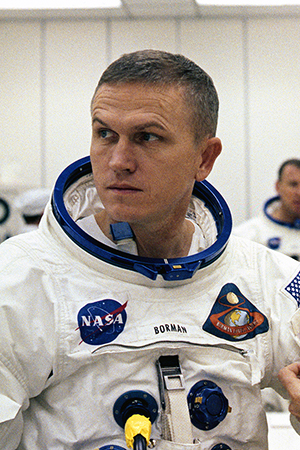
NASA astronaut Frank Borman, Apollo 8 commander, is seen being suited for launch in December 1968. (NASA)
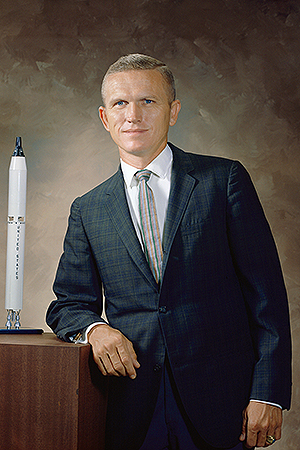
NASA astronaut Frank Borman poses for a portrait with a model of the Gemini-Titan II launch vehicle in 1964. (NASA)
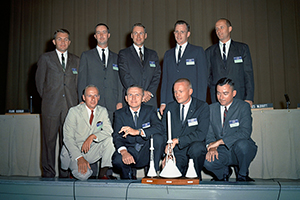
Frank Borman, second from left in front row, poses with his fellow members of the "Next Nine," NASA's second group of astronauts selected in 1962. The group includes Borman's future Gemini 7 and Apollo 8 crewmate Jim Lovell (center in back row). (NASA)
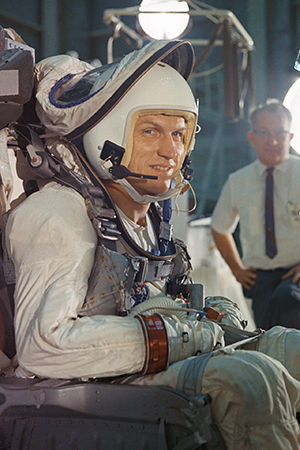
Frank Borman, command pilot for the Gemini 7 mission, is pictured during weight and balance tests in October 1965. (NASA)
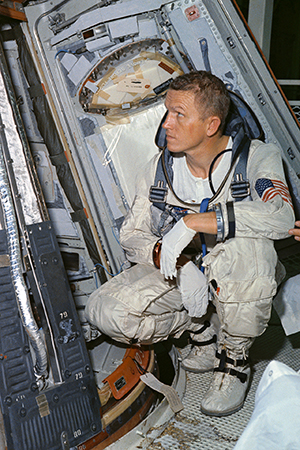
Frank Borman, command pilot, looks over the Gemini 7 spacecraft during weight and balance tests in October 1965. (NASA)
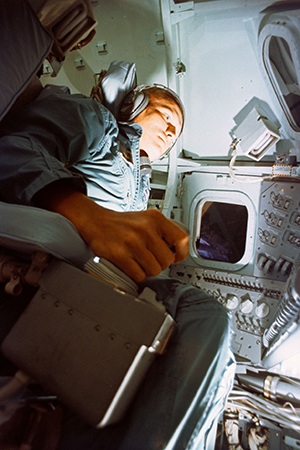
Frank Borman, Apollo 8 commander, trains in the Apollo mission simulator at the Manned Spacecraft Center in Houston. (NASA)
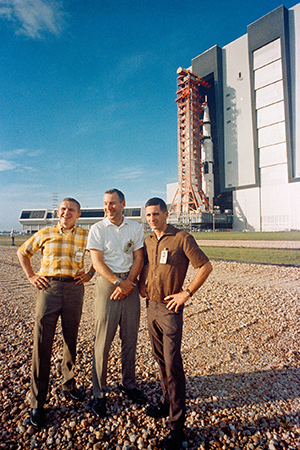
Apollo 8 crew members Frank Borman, Jim Lovell and Bill Anders stands in foreground as their Saturn V rocket leaves the Kennedy Space Center's Vehicle Assembly Building for the pad. (NASA)
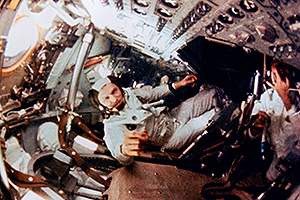
Frank Borman, mission commander, is shown on board the Apollo 8 spacecraft during the 1968 lunar orbit mission. (NASA) |
|

© collectSPACE. All rights reserved.
|
|

|

|
